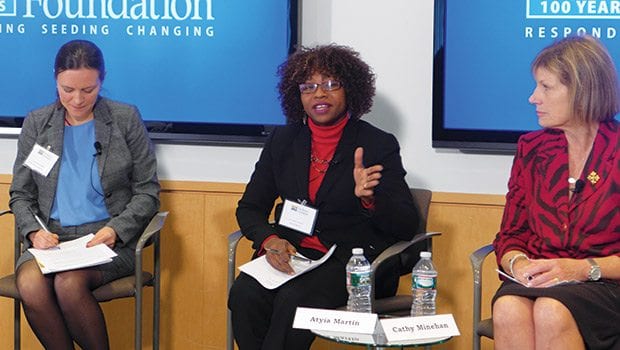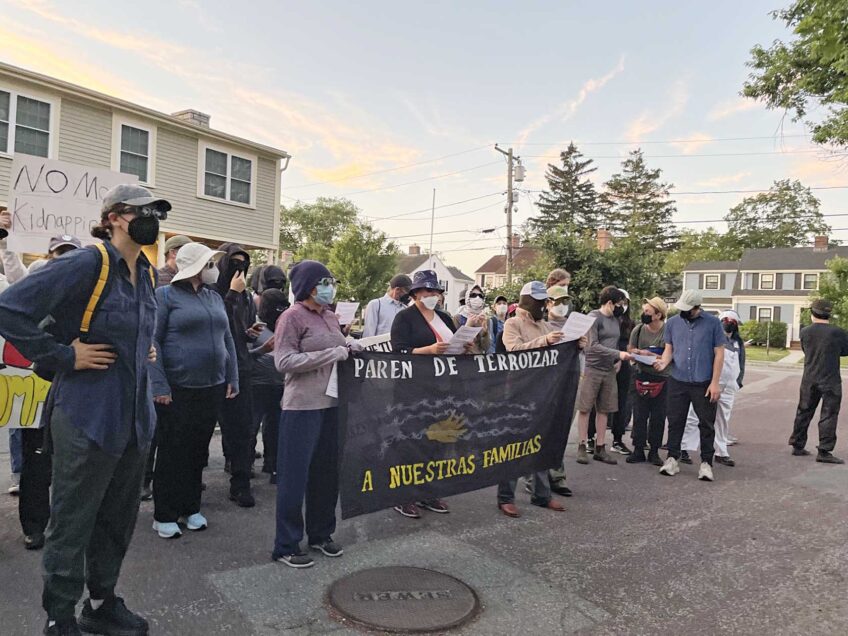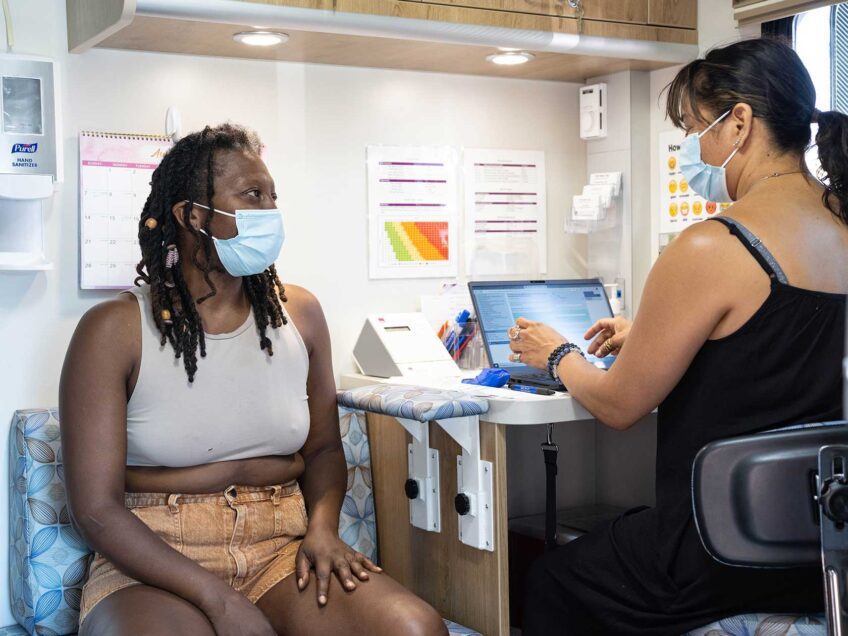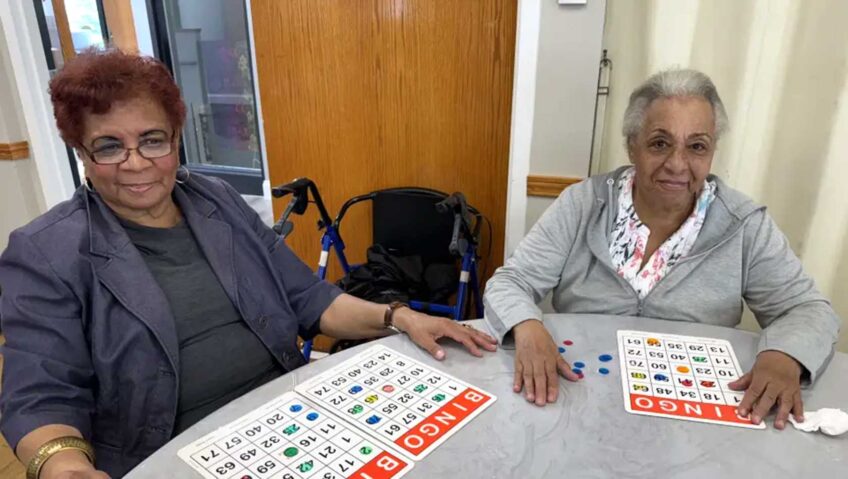
In the past few decades, the income gap between Boston’s very rich and very poor in Boston has widened significantly. In an opportunity forum on inequality in the city held last week, The Boston Foundation examined the causes behind the dramatic divide and asked what, if anything, the city can do to narrow it.
The forum was part of a series of public conversations held in connection with September’s release of “Shape of the City: Making Boston America’s Upwardly Mobile City,” the 2015 Boston Indicators Project report.
“Boston is not just one of the most unequal cities in region and nation, but globally as well,” said Jessica Martin, director of the Boston Indicators Project.
Speakers said equity gaps appeared as early as birth and that factors working for or against individuals’ chances at success include where they are born and their families’ past ability to accrue wealth.
Dramatic gap
Income growth in the city largely has come to those already earning the most, said Martin.
In the last 15 years, the highest-earning families saw their incomes rise by 42.5 percent, while for the lowest 20 percent, incomes rose only 14 percent.
In 2000, the top five percent of households earned approximately 44 times more than the bottom 20 percent. By 2013, that number grew to 54 times more, according to the Indicators Report.
Only two cities in the U.S. — Atlanta and San Francisco — are more unequal than Boston, Paul Grogan, president and CEO of The Boston Foundation said.
Education intervention
Early, higher and job-relevant education are among the most important drivers of upward social mobility, forum speakers said.
Many of the opportunities created by Boston’s economic growth affect those with high levels of education, said Grogan.
“It is an economy that places an ever higher premium on educational attainment. If you have that attainment, this is an economy that can richly reward you. If you don’t, it can be very costly,” Grogan said.
Children of families earning in the bottom 20 percent are significantly less likely to rise to higher income brackets if they do not complete college. For children born to such families who do not go on to attain a college degree, 45 percent of them will remain in the bottom 20 percent, Martin said.
“If they do earn a college education, we see much greater mobility — 20 percent will reach the top,” she said.
But the equity gap also is evident in discerning educational achievement.
Only 25 percent of Boston’s black and Latino adults have a bachelor’s degree or higher, according to the Indicators Report. Additionally, children from low- to middle-income families are enrolled in early education at the lower rates than children of wealthier families.
Generations in the making
The choices individuals make affect their success, but are not the whole picture.
“Opportunity at birth impacts success throughout the lifespan,” Martin said.
On average, only 10 percent of children born to households earning in the bottom 10 percentile will rise to the top earning bracket and more than a third will stay in the bottom tier, she said.
Children born into families with more money and assets have greater resources provided to them. Because whites traditionally have had greater economic opportunities, they often are better able to pass on more wealth than blacks, said Ana Patricia Muñoz, director of community development research in the regional and community outreach department for the Federal Reserve Bank of Boston.
Location matters
Additionally, the neighborhood where someone is born and grows up helps determine what resources are available to them.
Easy access to public transportation means easy access to jobs and other opportunities. Within a community, high concentrations of poverty and high rates of violence create chronic stressors. Better public schools and access to high-quality early education help prepare children for success.
As much as 20 percent of the gap in earnings between black and white adults can be attributed to place-based characteristics, Jessica Martin said. And Suffolk County is an especially hard place to live.
Across all household income levels, children growing up in Suffolk County can expect to earn less than children growing up in Middlesex County, she said. Likewise, adults who grew up in Suffolk County also earn about $1,200 less per year than adults who grew up in middle-income households across the nation, according to the Indicators Report.
New approach
Programs that try to solve the equity gap by focusing on changing behaviors and raising awareness falsely assume that opportunities are equally available to all and that paths to success are largely a matter of personal choice, Muñoz said.
“I think we assume everybody has the same choice and if they only knew how to make good choices, only knew to save and go to college,” Muñoz said.
Several speakers pointed out that any successful strategy must go further than education and create structural changes.
Policy and culture shift
There are clear steps that can be taken to narrow the equity gap and promote social mobility.
Major areas, said Noah Berger, president of the Massachusetts Budget and Policy Center, include improving education and access to it and implementing policies that would require all jobs provide the wages and benefits needed to support a family.
Berger presented it as a matter of political and cultural will.
“We could recognize that some people will work hard forty hours a week cleaning buildings. And we could make the decision as a city and a state to pay them enough to raise a family,” Berger said.
“We need policies that are not just about surviving, but really about thriving,” said Atyia Martin, the city’s Chief Resiliency Officer.
Many solutions are common sense, said Atyia Martin. She pointed to Xavier University in New Orleans, which became the top school nationally for graduating black pre-med students who go on to graduate from medical school
The administration took a student’s-eye-view to the situation, she said, and produced effective strategies like putting struggling students into study groups and making an effort to identify early on which students need help.
“It’s not rocket science,” Atyia Martin said.
The next step is directing resources to invest in these fixes and creating policy to enforce them.
“The challenge of course,” Berger said, “is [policies] all cost money.”
Disparate economic growth was not always the case. From 1947-1973, wages grew at a similar rate across income levels, said Berger. He credited the greater equity in part to strong unions that advocated for workers’ share in the profits and an economic policy committed to improving life for all income classes.
“It’s part laws, and it’s partially culture,” he said.






